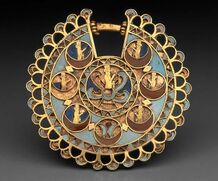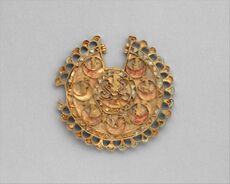Brief Identification[]

This Persian earring is from the Achaemenid Period (525-330 BCE), and is said to have been found in Mesopotamia [Simpson 1972, 120]. The Persian Empire was located in what is now modern day Iran. In the center of the earring a man is depicted emerging from a crest that has two wings and a tail, and the center is surrounded by six circles that depict smaller figures coming out of a crest while a seventh circle has a water lily in it. These figures are said to represent either the king and his six supporters or the god Ahura Mazda and the "Bounteous Immortals". The man emerging from a crest is a common depiction in Achaemenid art, and is believed to depict a divine figure in Achaemenid religion. A similar depiction was found in the tomb of Darius I and emphasizes how the religious connotations of the earring paralleled with his political ideologies.[1] This earring is now at the Museum of Fine Arts, Boston.
Technical Evaluation[]

Matching earring to the one found in the Museum of Fine Arts, Boston. This one is located in the Metropolitan Museum of Arts.
The earring was made out of gold with turquoise inlays, carnelian, and lapis lazuli. Achaemenid art was a blend of other cultures, and the technique used for hammering and shaping gold is thought to be adopted from the Medes. The technique used to create the earring was not advanced for its time, because the craftsmen blended techniques from different and previous cultures to form their art instead of creating a new technique. The Persians obtained materials from the lands in which they conquered, such as Egypt or modern day Afghanistan. The gold came from Egypt, the lapis lazuli and carnelian came from Bactria (Afghanistan) and Sogdiana, and the turquoise came from Chorasmia. [2] Darius I expanded trade via the Royal Road which linked the conquered lands to the heart of the Persian Empire, making it easier to access the materials. [3] The goldsmiths who made these items were Medes or Egyptians, and Darius I used many people to make not only the jewelry of the empire but to also build palaces [Collon and Perrot 2013, 350-54].
Local Historical Context[]
This earring is from the Persian Empire, and was created during the Achaemenid Period under the rule of Darius I. Under Darius I, the empire had expanded into Africa and other parts of Asia. The earring was made for the royalty in the empire, and similar depictions were found in the tombs of Darius I and his successors. The imagery on the earring correlated to the religious views of Darius I during his reign, and his loyalty to the god Ahura Mazda. The materials used for this earring were not local to the empire, so it was uncommon for people not of royalty to possess items such as this. It is believed that this earring was made for a noble or a noble woman, and it was presented as a gift [Simpson 1972, 120]. Although the earrings were believed to be a gift, it was not uncommon for craftsmen to be paid for their work. When Darius I built the palace at Susa, he kept treasury tablets that listed the wages of the sculptors, showing that craftsmen were usually paid for their sculptures and art. [4] The figures in the earring are said to be either the god Ahura Mazda or the king Darius I, and because Darius I believed himself to be closer to the gods it could be said that the earring represented the connection that only the king had with the supreme god.
World-Historical Significance[]
The Persian Empire and Persian art is usually viewed through what the Greeks wrote pertaining to the Persians. The discovery of not only this earring, but other jewelry gave insight on the Persian Empire without Greek bias [Curtis and Simpson 2010, 5]. The earring and the way in which it was made is similar to how Egyptians made their jewelry before the Persians conquered them [Curtis 2005, 132]. The similarities between the jewelry and how it is made shows how Persian culture adopted art styles from the cultures that they conquered. The earring is believed to represent Zoroastrianism, the religion of the Persian Empire. Persians used jewelry to spread their ideology, such as the creation myth [Curtis 2005, 150-151]. The Persians believed Ahura Mazda created "earth, who created yonder sky, who created man, who created happiness for man"[Curtis 2005, 151]. This creation myth could be represented on the earring by the six figures surrounding the central circle with Ahura Mazda in it. The creation myth is similar to the Christian God and the idea that he created earth. Also, the idea that the king was the only one who could speak to the gods was similar to that of the pharaohs in Ancient Egypt [Collon 2013, 464]. In art, Achaemenid artisans sometimes placed kings in places reserved previously for gods, and this more-than-human but less-than-godly depiction of Darius I was seen in multiple cultures, including ones that were under his rule. [5]
Suggested Bibliography[]
Collon, Gérard, and Jean Perrot. 2013. The Palace of Darius at Susa : The Great Royal Residence of Achaemenid Persia. London : I.B. Tauris, 2013.
Curtis, John., and John Simpson. The World of Achaemenid Persia History, Art and Society in Iran and the Ancient Near East. London: I. B. Tauris, 2010.
Curtis, John, Nigel. Tallis, and Béatrice. André-Salvini. Forgotten Empire : The World of Ancient Persia. Berkeley: University of California Press, 2005.
Simpson, William Kelly. "American Connoisseur: Acquisitions in Egyptian and Ancient Near Eastern Art in the Boston Museum of Fine Arts, 1970-71." The Connoisseur. 179 (1972): 113-122.
Colburn, Henry P. Art of the Achaemenid Empire,and Art in the Achaemenid Empire. Ann Arbor: University of Michigan. https://core.ac.uk/download/pdf/147823741.pdf
Museum of Fine Arts, Boston https://www.mfa.org/collections/object/earring-155819
Google Arts and Culture https://artsandculture.google.com/asset/earring/5wFgXIwS3g7fyw
The Achaemenid Persian Empire https://metmuseum.org/toah/hd/acha/hd_acha.htm
Art of the Persian Empire https://courses.lumenlearning.com/boundless-arthistory/chapter/persia/
Iran: Visual Arts: The Arts of the Achaemenids http://www.iranicaonline.org/articles/commerce-ii